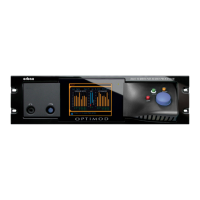OPTIMOD SURROUND PROCESSOR OPERATION
3-3
tween. Hence, the 2.0 processing’s AGC meters are split so that the left
and right gain reduction (or channel 1/channel 2 gain reduction in dual-
mono mode) are both displayed.
• GATE indicators show silence gate activity. They light up when the input
audio falls below the threshold set by the gate threshold controls. For a
given processor (surround or 2.0), there are two gates—one for the AGC
and one for the multiband limiter—each with its own G
ATE THRESHOLD con-
trol. When gating occurs, the AGC and compressor’s recovery times are
slowed drastically to prevent noise rush-up during low-level passages.
• M
ULTIBAND GAIN REDUCTION meters show the gain reduction in the multi-
band compressors. Full-scale is 25 dB gain reduction. These meters are split,
showing main gain reduction (the GR applied all channels but the center)
to the left and center channel gain reduction to the right. See Multiband
starting on page 3-11 for an explanation of how the main and center com-
pressors are coupled.
• L
IMITER GAIN REDUCTION meters show how much gain reduction the 8685’s
look-ahead limiters are producing.
• O
UT meters indicate the instantaneous peak output level at the output of
the 8685’s audio processing before the S
URROUND OUTPUT 100% or 2.0
OUTPUT 100% controls.
• HF
ENHANCER METERS show how much dynamic high frequency boost the
8685’s HF Enhancer is providing.
• L
OUDNESS LEVEL meter shows the subjective loudness of the output, meas-
ured by the 1981 Jones & Torick CBS Technology Center algorithm and by
the ITU. BS.1770 algorithm. (See page 1-18 for a discussion of the J&T algo-
rithm and Using the ITU BS.1770 and CBS Loudness Meters to Measure
Loudness Controller Performance on page 3-78.)
For each of the two loudness-metering algorithms, there is only one me-
ter for the surround processing and one meter for each 2.0 processor (in
stereo mode) because regardless of the number of channels and loud-
speakers in the listening room, a given listener has only one perception
of loudness. When a given 2.0 processor is operated in dual-mono mode,
there is one L
OUDNESS LEVEL meter for each mono channel.
The meter for a given processing chain is calibrated with reference to the
Dolby Digital® Dialnorm value that you specify in the 8685’s active Setup
for that processing chain. (See step 10 on page 2-14.) If you adjust the
processing so that the Loudness Level meter peaks at 0 dB on dialog
and
you set up your Dolby Digital encoder so that that you are transmitting
this same Dialnorm value to consumer receivers, your transmission will
have the correct loudness compared to other correctly set up transmission
channels.
• LOUDNESS GAIN REDUCTION shows the amount of gain reduction that the
8685’s CBS Loudness Controller is producing.

